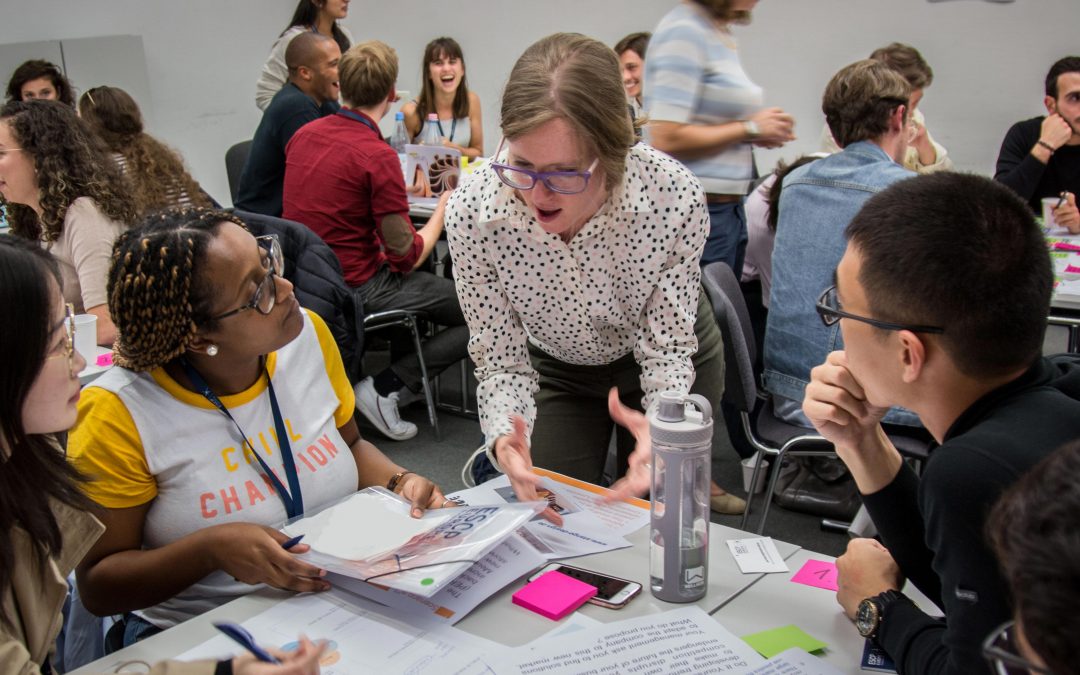
Rent it like it’s hot! Circular business models go for haute couture in Berlin
Rent it like it’s hot! Circular business models go for haute couture in Berlin
It’s the end of the year, and for some, this means dressing up, shopping, gifts, and a bit of bling and sparkle. I had the pleasure of donning some bright yellow party feathers on a rainy Black Friday a few weeks ago in Berlin’s Galeries Lafayette: all in the name of circular economy. Mais oui!
Let me present WeDress Collective, founded by valiant entrepreneuse Jasmin Manai-Huber. WDC allows you to hire haute couture items for a few days or longer, in your city, without having to buy, or you can rent out your own for a day or more. It has a pop-up store presence at Galeries Lafayette in Berlin until early January, on the ground floor (on the left when you walk in, for those in Berlin), off the Friedrichstrasse. WDC is otherwise present in Hamburg and Vienna so far, with plans to develop elsewhere.
It took me a bit of time to let go of my inhibitions about haute couture – I don’t own any, my clothes are more basse couture I’d say, often second hand no-names. So it was a privilege outside my usual non-bling bubble to be able to hold and touch some of the exquisite garments I could now rent from someone in my city. I can’t quite think when I might wear that (chic) chick yellow feather dress in my everyday life, but voilà, being able to walk around in a dress I’d never normally get to touch was a fun, unexpected live 3D post pandemic experience…
… And we need more such experiences to make circular economy and being (more) sustainable inspiring and, yes, fun. After two years of Corona and now inflation-driven austerity, telling people to just tighten their belts and be greener is rarely an attractive proposition. Fashion is one of the major culprits in our consumption-driven, wasteful culture, so there is much progress to be made. We need to value the clothes we already have, and keep them circulating for much longer – and develop business models that work based on this. Why? So that we cut the use of raw materials, transport and massive waste that have such negative environmental and social impacts. The second-hand fashion market in 2021 was valued at around $36bn, according to thredUP’s Annual Resale Report. This is expected to grow to $77bn by 2025.
Clearly haute couture and renting it out, or renting it for oneself, is hardly within everyone’s reach or aspirations. As I stood there with young and older fashionistas mingling with guests from Zalando and H&M who’d come to investigate, I mused: these circular business models need to address all segments of the population. And if those owning or wearing haute couture are inspired – likely part of that top 5-10% with the highest carbon footprints – then all the better. Chanel & co will just have to catch up. Now I need to find an event for my first WDC rental. Perhaps not the safety pin hat or the yellow feather dress pictured above, but a nice green jacket for my next keynote talk might be an idea.
Dress: courtesy of David Tomaszewski – I had a lot of fun wearing his creation, despite not being equipped with the right shoes (heels would have been better, arriving in the rain by bike was not ideal!).
Handbag: STAUD, founder’s own.
Photo: Nhu Ha Dao, co-founder of circular power suit Berlin/Copenhagen startup LOTTA LUDWIGSON which I had the pleasure of mentoring earlier this year at Impact Hub Berlin, alongside a dozen other circular startups. Good to meet her here!
Thanks to WDC Founder Jasmin Manai-Huber, who it was a pleasure to meet in person courtesy of one of my circular economy networks.
Tips and takeaways for Readers: (CUT)
-
Think about renting a special outfit next time you have a big, special event and see what services might exist in your area by searching online, asking your local Zero Waste firm
-
Try to buy quality electronic goods if you do have to buy new: do your homework, check what they are made of, what plastics they are made with, how long the brand has been around, any policies on repair, modular design, which parts are likely to wear and tear first and which parts can be replaced.
Links / Credits:
-
WeDress Collective website: https://www.wedresscollective.com/en/home
-
circular fashion statistics: https://ecothes.com/blog/fast-fashion-statistics
- Lotte Ludwigson



